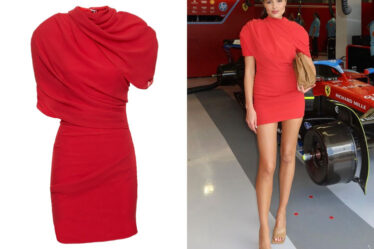
Levi’s wants shoppers to “live in” more than just its jeans.
On Monday, the brand released a new campaign celebrating the 10-year anniversary of its Live in Levi’s tagline, first introduced in 2014. The 60-second spot, which will live in various formats across television, social media, streaming and out-of-home, shows a group of friends sitting on the couch watching TV — naturally, all wearing Levi’s. Bored, they flip the channel to a music video, and one, struck with inspiration, hops up to start dancing. Her moves quickly do more than inject energy into the room — she flips the coffee table after landing on the ground after a jump. The rest of the group gets up to join her, and the entire room begins to tilt as an original song from producer and DJ Kaytranada plays in the background.
The ad, which is called “The Floor is Yours,” ends with the screen panning out to show the scene playing on another TV screen, being watched by another bored pair. One of them leans forward, a glint in her eye — she’s about to hop up and do the same thing.
As part of the campaign, Levi’s is issuing a global casting call, asking shoppers to film their own video recreating the dance moves seen in the spot. It’s an apt time for the brand to issue such a call to consumers, who they’re increasingly hoping to speak more directly to in the future.
Levi’s in the midst of a transitional moment. The nearly 171-year-old company, one of the oldest operating retail brands in the United States, is currently on a mission not only to shift how consumers consider Levi’s, but also where they shop for its products.
Last year laid bare the vulnerabilities of the brand’s historic reliance on wholesale: In January, Levi’s announced it had missed revenue estimates for the fourth quarter, and planned to cut 10 to 15 percent of its corporate jobs.
To course correct, Levi’s wants to refocus on its direct-to-consumer business both online and in stores; currently accounting for 40 percent of its sales, it wants to increase that number to 55 percent by 2027. As well, Levi’s is hoping to get shoppers to think of them for more than just pants, and pick up tops and jackets, such as a $70 denim corset or a $198 denim trench coat, while they’re shopping for a pair of jeans. The idea, Mitchell said, is to get consumers to embrace the idea of “denim dressing,” head to toe.
“We’re looking to tell the story around this idea of being this unofficial uniform for progress,” Kenny Mitchell, Levi’s chief marketing officer, who joined the company in June 2023, said of the inspiration behind the campaign, his first major campaign for the brand. “We talk about progress as this idea of movement. It’s about being a doer and taking action. Progress isn’t for folks that sit on the sidelines.”
This campaign is one of the first steps in making that push.
A New Chapter for Levi’s
But changing consumer perceptions about a brand — from what to buy from them to where to buy it — is easier said than done, particularly for a brand with as rich a history as Levi’s. The brand’s challenge now is to push Levi’s forward without losing sight of that.
“It’s a great benefit to have this history and legacy,” said Mitchell. “It’s fantastic to be able to play with our past and bring that into the future in really creative ways.”
The campaign is meant to reflect that bring-the-past-into-the-future mindset. Levi’s, Mitchell said, has a history of being tied to music — it was one of the first apparel brands to run ads on the radio, for example, with a soundtrack by Jefferson Airplane, and has used music in countless ads since.
“Every choice we made creatively was guided by … how Levi’s really wants to position itself moving forward as this modern denim lifestyle brand,” said Erin Riley, chief executive of TBWAChiatDay USA, Levi’s creative and social agency partner and the agency behind the campaign.
If the goal is to deepen consumers’ connection with Levi’s, prioritising stores is a good initial step, said Allen Adamson, co-founder and CEO of marketing agency Metaforce.
There, shoppers can see Levi’s full assortment and talk to employees that are experts about the brand.
“To change the fundamental perception of a brand’s image, they’ve got to go direct to consumer, because wholesalers don’t have the skill set and funds to do that,” Adamson said. “It’s a marathon, but they had to start in this direction.”
However, it’s important to maintain the balance with wholesale, as those sort of purchasing patterns can be difficult to shift — think of Nike, which is currently facing slowed momentum and sales after pulling back on wholesale partnerships.
In terms of getting people to think of Levi’s as more than just a bottoms destination, Mitchell said he’s starting with zeroing in on Levi’s brand identity, and then applying that to future marketing initiatives that will highlight the brand’s tops or jackets assortment. The same way previous campaigns would spotlight classic items like the brand’s Trucker jackets or 501 jeans, future ads will highlight t-shirts or accessories.
If it works, Levi’s will be able to increase its sales and begin to expand the brand’s definition for consumers. Still, for a company that’s about as synonymous with bottoms as it gets, it’ll be an uphill climb to get people to think of them differently.
“The further you go away from the core, the more challenging it gets,” said Bob Phibbs, CEO of consultancy The Retail Doctor.



